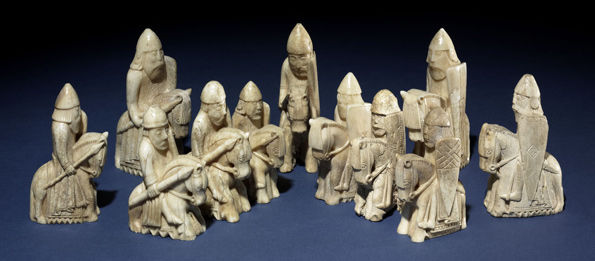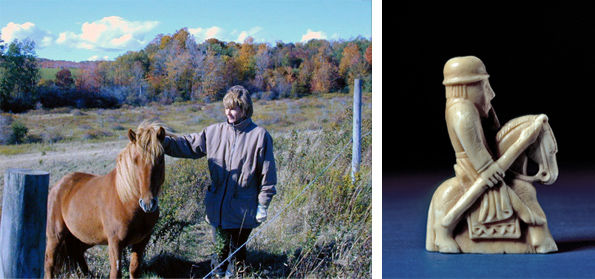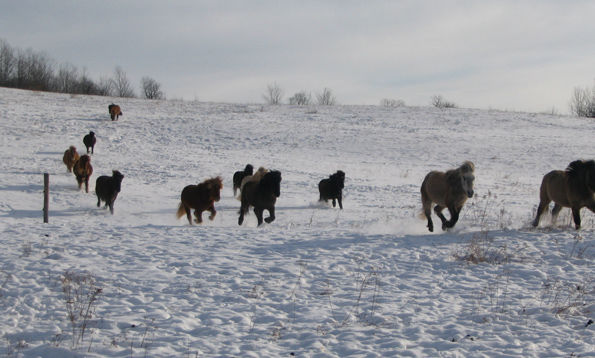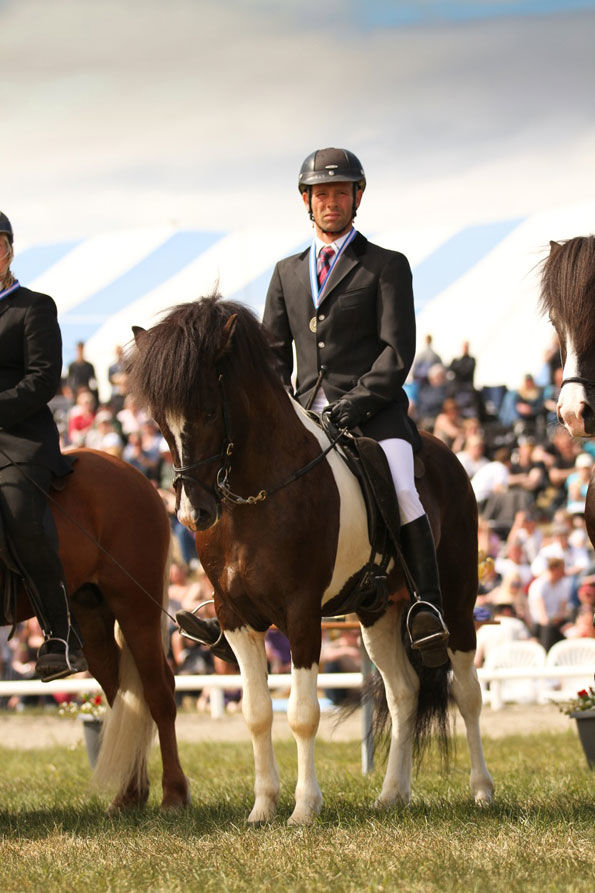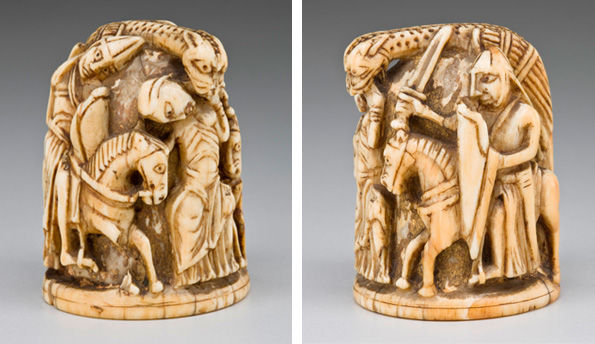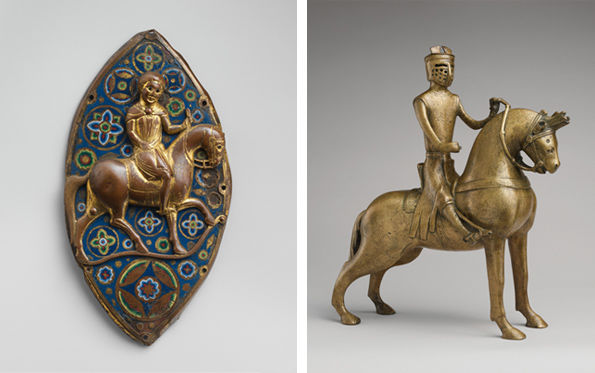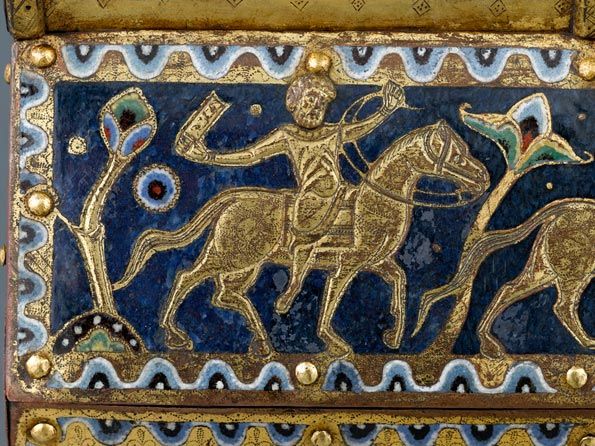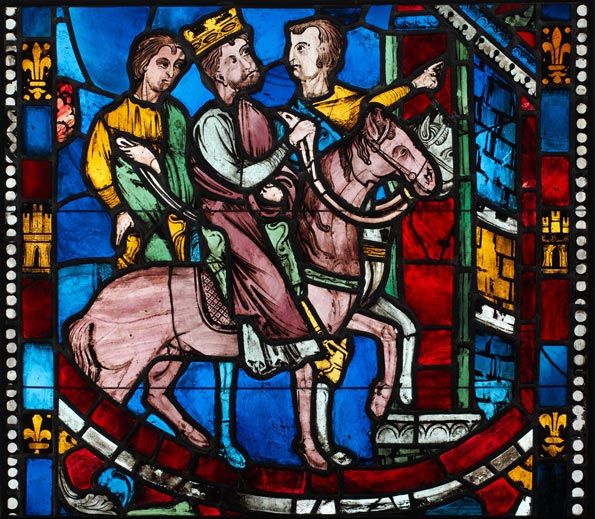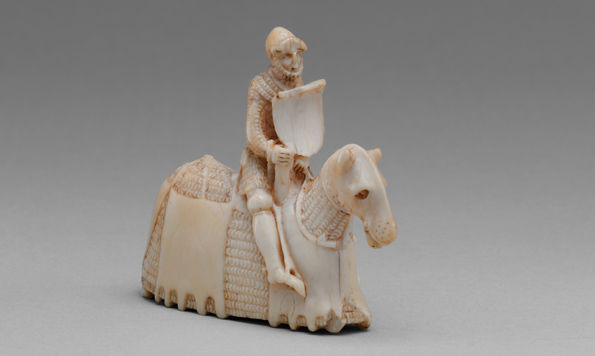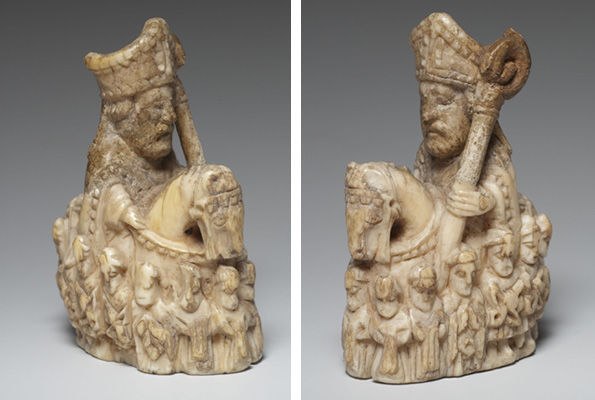Top: Knights, ca. 1150–1200. Scandinavian, probably Norway, found on the Isle of Lewis, Outer Hebrides, Scotland, 1831. Walrus ivory. The British Museum, London (1831,1101.103–.110, .112, .114–.115) © The Trustees of the British Museum. All rights reserved. The bottom row shows individual pieces from the same group. From left to right: 1831,1101.102, .102 and .113, and .115.
Long forelocks falling over the eyes, groomed manes, tails that reach to the ground, and a short, stocky frame distinguish the horses ridden by the Knights of the Lewis Chessmen. They seem to resemble today's Icelandic horses. I spoke to Heleen Heyning, a breeder of Icelandic horses at West Winds Farm in upstate New York. She immediately saw the resemblance between the Lewis horses and her own. She noted that Icelandic horses were known across Scandinavia in the Viking area and are thought to have been introduced to Iceland about the year 800. For the last thousand years—that is, since before the Lewis Chessmen were carved—there has been no crossbreeding of Icelandic horses. Therefore, the resemblance we see is not accidental.
Left: Heleen Heyning of West Winds Farm, with Icelandic horse. Right: Knight, ca. 1150–1200. Scandinavian, probably Norway, found on the Isle of Lewis, Outer Hebrides, Scotland, 1831. Walrus ivory. The British Museum, London (1831,1101.102) © The Trustees of the British Museum. All rights reserved.
Icelandic horses of West Winds Farm
Knights, ca. 1150–1200. Scandinavian, probably Norway, found on the Isle of Lewis, Outer Hebrides, Scotland, 1831. Walrus ivory. The British Museum, London (1831,1101.103–.110, .112, .114–.115) © The Trustees of the British Museum. All rights reserved.
Heleen notes that Icelandic horses are sturdy and strong, completely capable of sustaining the weight of a full-grown man (which is not the case, for example, with Shetland ponies), and remarkably agile, making them ideally suited for the battlefield.
Icelandic horse and rider. Photo: Martina Gates
One could argue that the relatively small size of the Lewis horses reflects a degree of artistic license, which can also be seen elsewhere: notice, for example, the tiny feet of the knights, which surely would have proved inadequate to support their size.
Still, the relatively small stature of the Lewis horses appears consistent not only with the Icelandic breed, but also with information from certain medieval records. The horses of the Crusaders of the end of the eleventh century, for example, are thought by some to have been relatively small, no more than 12–14 hands (48–56 inches) high,1 while another source, basing calculations on the size of the stalls in medieval ships destined for the Holy Land, estimates that the stallions were about 15 hands high (60 inches).2 (Today, a horse that is under 14.2 hands high is classified as a pony. A thoroughbred today is about 16 hands high.) A chess piece in the Oberlin College Allen Memorial Art Museum presents two knights bravely battling a dragon while riding especially small horses; the carving is so imaginatively conceived that one is inclined to think that the proportions have no basis in fact.
Chess Piece of a Knight, ca. 1120–40. English. Ivory. Allen Memorial Art Museum, Oberlin College, Oberlin, Ohio, R. T. Miller Jr. Fund (1948.310)
However, a document concerning one Richard, son of Asclettin, a Norman living in Italy in the eleventh century, suggests otherwise: the horse he rode was so small that his feet touched the ground! To some extent, size seems to have been in the eye of the beholder: a Muslim chronicler of the Crusades, Usamah ibn Munqidh (1095–1188) describes a black horse ridden by a French knight as being as large as a camel!3
It is generally agreed that, through breeding and trade, the size of horses increased dramatically from the eleventh to the fourteenth century. Thus the horses of the Lewis Chessmen are significantly smaller, relative to their riders, than the elegant steed that appears on a Limoges plaque of the mid-thirteenth century in the Metropolitan's collection, or the muscular dappled horse of our thirteenth-century Knight Aquamanile.
Left: Equestrian Plaque, ca. 1220. Made in Limoges, France. The Metropolitan Museum of Art, Gift of J. Pierpont Morgan, 1917 (17.190.854). Right: Aquamanile in the Form of a Mounted Knight, ca. 1250. Made in probably Hildesheim, Lower Saxony, Germany. The Metropolitan Museum of Art, New York, Gift of Irwin Untermyer, 1964 (64.101.1492)
Medieval works of art that represent the three Magi coming from the East to pay homage to the infant Jesus add an element of luxury and exoticism by presenting them as owners of dappled horses.
Chasse with the Adoration of the Magi (detail), first quarter 13th century. French, Limoges. Gilded copper on a wood core with champlevé enamel. Musée National du Moyen Âge, Thermes de Cluny, Paris (Cl. 23822)
Though it cannot be judged from the Lewis chess pieces, we know from documents that the color of medieval horses was quite varied, as it is today. According to medieval Bestiaries, "the chief colours are bay, chestnut, golden, rosy chestnut, stag-colored, pale yellow, grey, dappled, greyish-white, white, piebald, black: then there are horses with mixed colors, such as bay and black." Where horse color is indicated in a work of art, how can we discern what is artistic fancy and what is intended to mimic a real horse? In The Cloisters stained-glass panel from Rouen, does Theodosius ride a red roan and one member of his entourage a dapple gray? Maybe, but then how can we account for the turquoise-blue horse of his second companion? A blue roan? More likely, purple was chosen simply to connote an imperial figure—the color horse an emperor would ride, if it existed!
Theodosius Arrives at Ephesus from a Scene from the Legend of the Seven Sleepers of Ephesus, ca. 1200–05. Made in Rouen, France. The Metropolitan Museum of Art, New York, The Cloisters Collection, 1980 (1980.263.4)
The color of horses is often specified in noble and royal accounts (so, sometimes, are the horses' names!). The list of horses of Henry Burghersh, bishop of Lincoln, (1292–1340) includes one that was black with a white star, a white horse, a dapple grey, and one described as the color of "morel," the brown-black mushroom.4 Four "morel" horses were among the twenty steeds (one of them described as a "palefoi"—a particularly valuable riding or parade horse—and another as missing an eye!) that figure in the inventory of Clémence of Hungary, widowed queen of Louis X of France, at her death in 1328.
The horses of the Lewis Chessmen have been carefully groomed. A devoted lecturer at The Cloisters who is also a horsewoman informs me that two of them have manes that appear to have been "roached," or shaved so that they stick straight up in the air (see video). Such roaching or "hogging" is useful for breeds with shaggy manes. The forelocks of the horses, however, are long, like those of Icelandic ponies today, which are allowed to grow to protect the horses' eyes from snow.
According to medieval Bestiaries, horses "can scent battle, and the sound of the trumpet encourages them to fight." Moreoever, "If men go to battle, they can foretell the outcome by the eagerness (or lack of it!) of their horses."
The horses of the Lewis Chessmen have no protective gear, horse armor having only developed in the late twelfth century, as seen on this chesspiece in the Metropolitan's collection:
Chess Piece (Knight), ca. 1510–30. Western European, possibly German or English. Ivory. The Metropolitan Museum of Art, New York, Pfeiffer Fund, 1968 (68.95)
The knights of the Lewis Chessmen sit astride their steeds on high-backed saddles set over long blankets; they control the horses by the use of a bit, bridle, and reins. We can't see the underside of the feet of the Lewis horses, but the chronicler Snorri Sturleson claims that the Crusader King Sigurd Jorsalafar ["Jerusalem-farer"] of Norway (died 1130) shod his horse with golden shoes!
Even without golden shoes, a horse was an expensive creature to maintain in the Middle Ages. One estimate suggests that the daily cost of feeding a horse was greater than the daily earnings of a skilled mason. A fourteenth-century English account reveals that, in winter, a horse would consume half a bushel of oats each day along with three loaves of bread made especially for them from a mixture of peas, beans, and oatmeal.
Compounding the cost was the number of horses required: English Knights of the early twelfth century typically owned at least three horses. But don't be fooled by the fact that only chess knights have battle horses: as a participant in the Hundred Years' War, Henry Burghersh, bishop of Lincoln, had six horses for his personal use and nearly as many for each of the men in his entourage. Indeed, chess pieces in the form of bishops sometimes show them on horseback.
Chess Piece of a Bishop, 14th–15th century. German. Ivory. The British Museum, London (1857,0804.34) © The Trustees of the British Museum. All rights reserved.
From at least as early as the twelfth century, if a horse was killed in battle, the king would typically compensate its owner for the loss. If a horse became ill through natural causes, he would be treated with medieval remedies that included wine vinegar, honey, or olive oil, and ointments were made from substances like fenugreek, frankincense (wildly expensive), and ginger.
The early fourteenth-century accounts of the Count of Artois indicate that wine was used to wash the horse's legs. An equine veterinarian in Montana tells me that today, wine is sometimes used with horses as a wound dressing—mainly for a condition called "scratches," which is found on the lower extremities above the hoof and occasionally up to the cannon bone. Horses afflicted with scratches typically lose hair, have oozing wounds, and are very sensitive to touch. The tannins from red wine (or even black teas) help dry out the environment around the lesions and likely provide a degree of antimicrobial support as well.
The Montana veterinarian further reports that honey, especially when made from the nectar of plants that contain important antimicrobial phytochemicals, is useful when applied to infected wounds because it destroys bacteria. Honey is acidic, and most bacteria that infect wounds can't survive in an acidic environment. Due to its viscosity, honey also draws out fluid/exudate from the infected wound (via osmosis), preventing the bacteria's access to water, which disrupts the bacteria's ability to proliferate. Finally, an enzyme in honey called glucose oxidase produces hydrogen peroxide from honey's sugary environment; hydrogen peroxide promotes potent antimicrobial support at the honey and wound interface.
Dr. Cynthia Lankenau, current president of the Veterinary Botanical Medical Association (VBMA), tells me that she uses most of the substances used by medieval practitioners on a daily basis. Vinegar is used as a solvent in the preparation of herbal products and is given orally for its nutritional value. Olive oil serves as a topical in many dermatological cases. It is also a great source of essential fatty acids and is fed as a nutritional supplement. Fenugreek is widely used today as a spleen tonic. Horses today are suffering from an almost epidemic level of metabolic disease. Fenugreek is a nutritive tonic, and a bitter digestive tonic that can be used in the treatment of diabetes mellitus and hyperlipidemia. Frankincense is widely used both topically and internally in the treatment of painful arthritic conditions. Ginger is also widely used today. This herb can enhance and moderate the action of other herbs. It has antimicrobial, antipyretic effects. It can help treat acute respiratory infections and also help situations of poor peripheral circulation. It can assist in cases with poor digestion and colic.
Needless to say, the practice of tying a sheepskin around the neck of an ill horse or of using "dragon's blood" as a cure are uniquely medieval. But there is a resurgence of interest in natural medicine for horses, as current research supports the use of many remedies. Many of these were recorded in the thirteenth century, when Jordanus Ruffus wrote a fifty-seven-chapter veterinary handbook for horses, De Medicina Equorum. Forty-one manuscript copies of his work survive, in six different languages. Printed editions were available by 1492. His treatise served as the basis for at least three other books on the care of horses. Like the ivory horses of the Lewis Chessmen, such texts provide yet another indication of how highly valued horses were in the medieval world, as they are today.
Sources and Further Reading
Hyland, Ann. The Medieval Warhorse, from Byzantium to the Crusades, Dover, N.H., 1994
Davies, R. H. C. "Warhorses of the Normans," Battle 10, (1987), 67–82 and The Medieval Warhorse (London 1989)
Prestwich, Michael. Armies and Warfare in the Middle Ages: The English Experience (New Haven and London: 1996)
[1] John France, "Technology and Success of the First Crusade," War and Society in the Eastern Mediterranean, 7th-15th Centuries, Yaacov Lev, ed., Leiden, New York and Cologne, 1997, p. 165.
[2] Ann Hyland, The Medieval Warhorse from Byzantium to the Crusades, Dover, N.H., 1994, 145–6.
[3] Hyland, p. 164.
[4] C. M. Woolgar, The senses in late medieval England, New Haven, 2006, p. 159.
